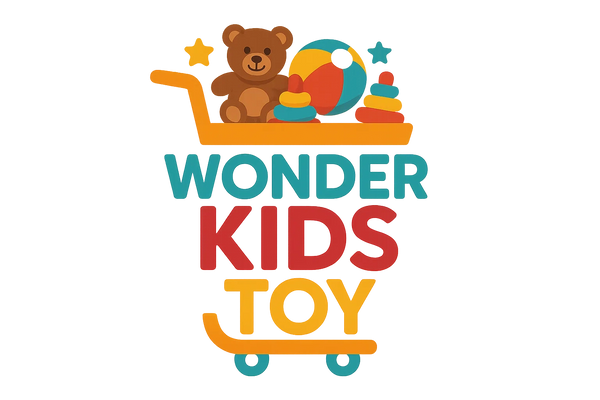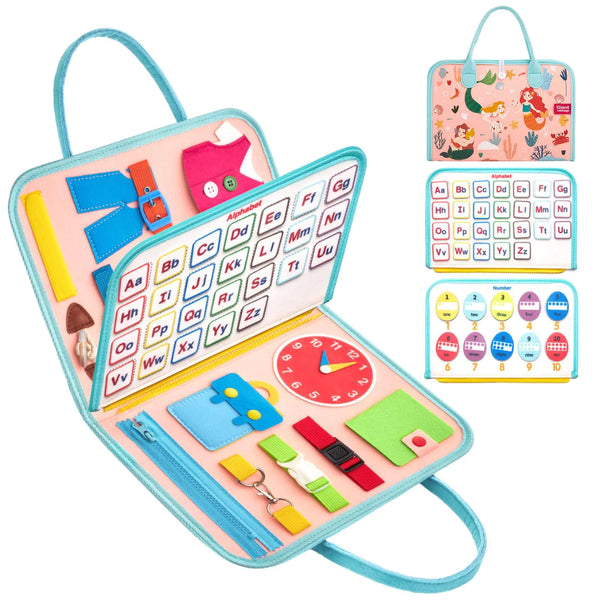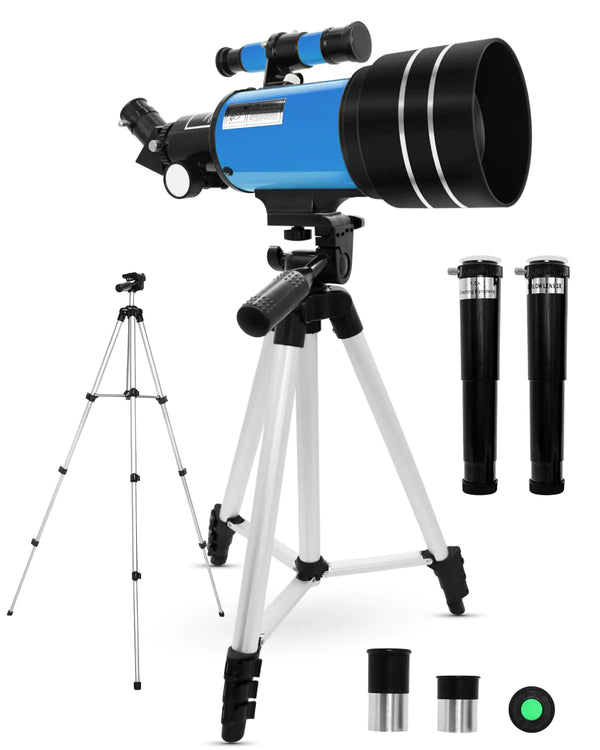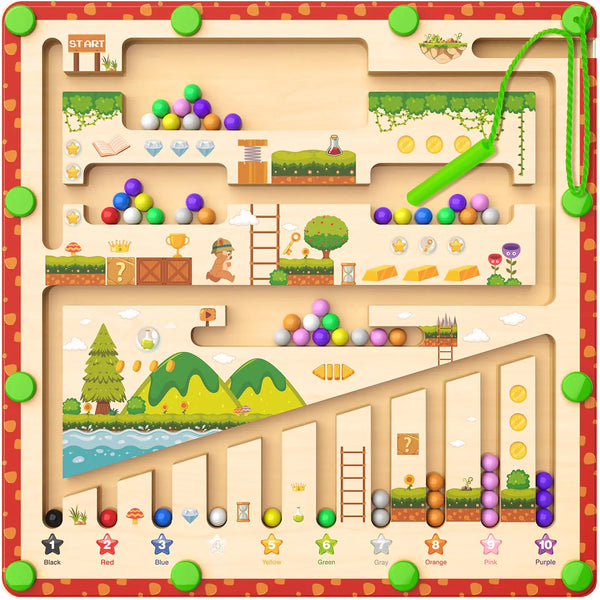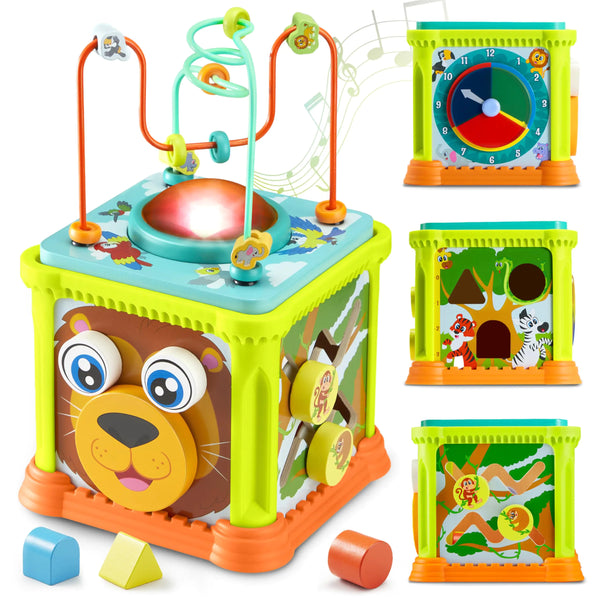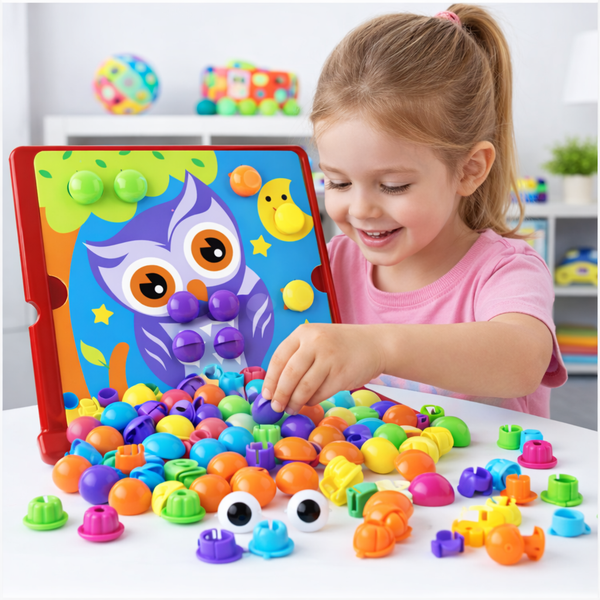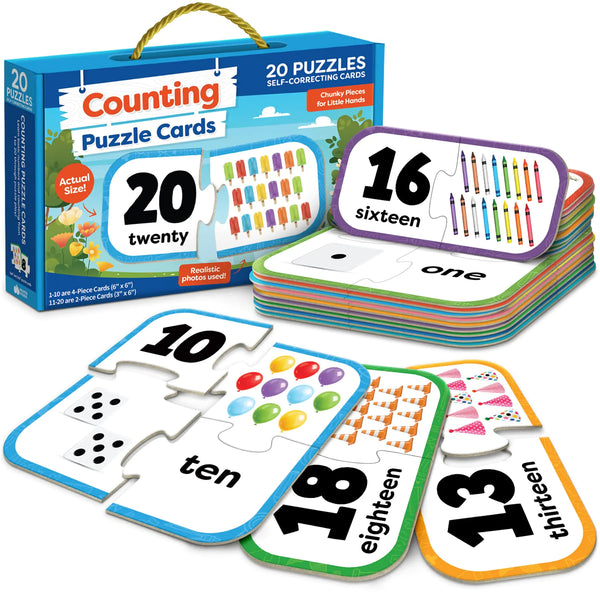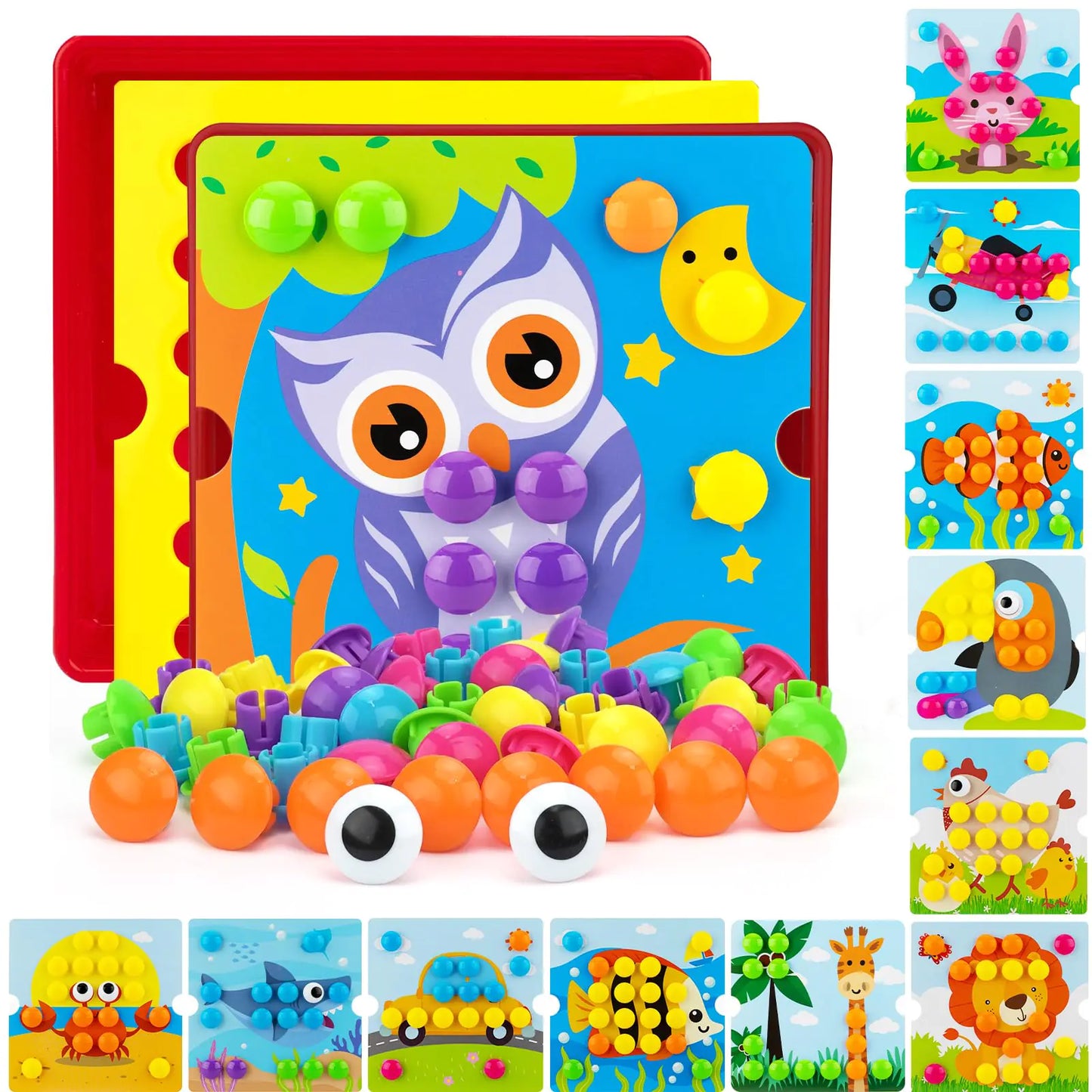Watching your child grow and become independent is amazing. For 2-year-olds, this is a key time. The right educational toys can really help.
Montessori Toys are made to help kids learn on their own. They encourage kids to explore and learn at their own speed.
In this article, I'll share my best picks for Montessori Toys that help 2-year-olds become more independent.
Key Takeaways
- Understanding the importance of independence in 2-year-olds
- How Montessori Toys promote self-directed learning
- Top recommendations for Montessori Toys that foster independence
- Tips for choosing the right toys for your child
- Encouraging your child to explore and learn at their own pace
What Are Montessori Toys and Their Benefits?
Montessori toys are more than playthings. They are tools designed to help kids learn independently and develop practical skills. These toys follow the Montessori method, which supports self-directed learning and hands-on activities.
Understanding the Montessori Method
Dr. Maria Montessori created the Montessori method. It focuses on learning that comes from the children themselves. It lets kids explore, discover, and learn at their own speed.
This method is known for:
- Self-directed learning
- Hands-on activity
- Collaborative play
- Uninterrupted work periods
It helps kids become independent, self-motivated, and love to learn. Montessori materials and activities are made to be hands-on. This lets kids learn by doing.
Importance of Independence in Early Childhood
Independence is key to a child's growth. It builds confidence, self-reliance, and problem-solving skills. Independent kids are more likely to take risks, explore, and learn from their experiences.
Some benefits of independence in early childhood include:
- Enhanced problem-solving skills
- Improved self-confidence
- Better adaptability to new situations
Using Montessori toys and principles in daily life helps parents support their child's independence. This supports their overall development.
Top Features to Look for in Montessori Toys

Choosing the right Montessori toys for 2-year-olds is key. It's essential to look for features that ensure safety and support development. This helps your child grow and learn.
Safety and Durability
Safety is the top priority when picking toys for 2-year-olds. They love to explore by touching and tasting things. So, toys should be made from non-toxic materials and free of small parts that could pose a hazard.
Also, toys need to last a long time. Wooden Montessori toys are great because they're durable and eco-friendly.
| Material | Safety Features | Durability |
|---|---|---|
| Wood | Non-toxic finishes, smooth edges | High |
| Plastic | BPA-free, no small parts | Medium |
| Natural Fibers | Hypoallergenic, non-toxic | Medium to High |
Age Appropriateness
Montessori toys are made to fit the child's age. For 2-year-olds, toys that help with fine motor skills are best. This includes stacking and sorting games.
It's also key to pick toys that are just the right level of complexity. Toys that are too easy or too hard can be frustrating.
Materials and Design Considerations
The materials in Montessori toys are essential. Natural materials like wood and cotton are beneficial because they feel nice and are environmentally friendly.
The toy's design matters too. Montessori toys are made to be self-correcting. This lets kids learn by trying things out. It helps them become independent and solve problems.
By considering these factors, parents can find Montessori toys that suit their child. These toys help kids become independent and love learning.
My Favorite Montessori Toys for 2-Year-Olds

I've picked out my top Montessori toys for 2-year-olds. These toys help kids become more independent. At this age, kids start exploring and wanting to do things on their own. Montessori toys are designed to help with this by providing fun, self-led activities.
Wooden Building Blocks
Wooden building blocks are key in Montessori learning. They improve hand-eye coordination and fine motor skills and spark creativity. These blocks are tough and made from real materials, fitting perfectly with Montessori's values.
Shape Sorting Toys
Shape sorting toys are a hit with 2-year-olds. They boost problem-solving and hand-eye coordination. Kids learn to match shapes with slots, which sharpens their thinking.
Practical Life Activities Kits
Practical Life Kits teach kids about daily tasks, boosting independence. These kits include tasks like pouring and sorting. They help kids improve their hand skills and learn to take care of themselves.
| Toy | Benefits | Age Suitability |
|---|---|---|
| Wooden Building Blocks | Develops fine motor skills, encourages creativity | 2+ years |
| Shape Sorting Toys | Enhances problem-solving skills, hand-eye coordination | 2+ years |
| Practical Life Activities Kits | Promotes independence, fine motor skills | 2+ years |
These Montessori toys are not just fun. They lay the groundwork for a lifetime of learning and self-reliance. By picking toys that follow Montessori's teachings, parents can really help their kids grow.
How Montessori Toys Foster Independence

Montessori toys are key in helping kids become independent. They encourage kids to learn and solve problems independently. These toys are designed to support the Montessori approach, which values independence and self-reliance.
Encouraging Problem-Solving
Montessori toys help kids develop problem-solving skills. Toys like shape-sorting puzzles and wooden blocks help kids think and solve problems on their own. This boosts their thinking and makes them feel proud and confident.
For example, a shape-sorting toy encourages kids to fit shapes into slots. This activity helps with critical thinking and perseverance, which are necessary for being independent.
Promoting Fine Motor Skills
Montessori toys also help with fine motor skills, which are needed for everyday tasks. Toys that involve stacking, nesting, or handling small objects improve hand-eye coordination and dexterity.
Stacking wooden blocks or cups, for instance, requires precision and control. This improves a child's fine motor skills. As kids improve their skills, they become more confident doing things on their own, which helps them become more independent.
By using Montessori educational toys, kids get the tools they need to grow independently. As they get older, these skills will help them tackle more complex tasks and responsibilities.
The Role of Play in Child Development

Play is key in child development, touching many areas of growth. It lets kids explore, learn new things, and grow socially and emotionally.
Play as a Learning Tool
Play is more than fun; it's a powerful way to learn. Montessori toys are made to help kids learn through play. They help kids solve problems, think critically, and be creative.
"Play is the highest form of research." - Albert Einstein
Playing with Montessori learning toys helps kids better understand the world. These toys are educational, teaching essential skills for school and beyond.
Social Skills and Cooperative Play
Play is also vital for social skills. Cooperative play teaches kids to share, take turns, and work together. This is key to strong social skills and a sense of community.
| Benefits of Cooperative Play | Skills Developed |
|---|---|
| Enhances social interaction | Communication, empathy |
| Fosters teamwork and collaboration | Problem-solving, mutual respect |
| Promotes emotional intelligence | Self-awareness, self-regulation |
Using the Best Montessori toys in play helps kids grow socially, emotionally, and intellectually. Play is essential to child development and should be highly valued.
Tips for Choosing the Right Montessori Toys

Finding the perfect Montessori toys for your toddler starts with understanding your toddler's likes and your home's space. As a parent, it's key to pick toys wisely. They significantly impact your child's growth.
Observing Your Child’s Interests
Watching what your child loves is key to picking the right toys. This helps you find toys that will keep them interested and challenged. For example, if they love blocks, Wooden Montessori toys, such as block or stacking toys, are great. They help with fine motor skills and problem-solving.
Children often enjoy activities that feel like real tasks. Practical life activities kits are perfect for this. They let your child do things like pouring, sorting, or cleaning, helping them become more independent.
"The greatest sign of success for a teacher is to be able to say, 'The children are now working as if I did not exist.'” - Maria Montessori
Considering Space and Storage
When picking toys, think about how much space you have and how to store them. It's easy to buy too many toys, but keeping things tidy is essential. Choose fun toys that are small and easy to put away.
| Toy Type | Space Consideration | Storage Tip |
|---|---|---|
| Wooden Building Blocks | Compact when stored | Use a wooden crate or basket |
| Practical Life Activities Kits | Can be spread out during use | Store components in labeled containers |
| Shape Sorting Toys | Typically compact | Store in a designated shelf or box |
Think about your child's interests and the space you have to create a good environment. This helps your child grow and explore freely. The goal is to make a space where your child can learn and have fun at their own pace.
Creating a Montessori-Friendly Play Environment

The design of our child's play area significantly affects their learning and growth. Reflecting on Montessori activities, we see the environment's key role. It encourages independence and a love for learning.
Organizing Toys for Accessibility
Creating a Montessori-friendly play area means organizing Montessori learning toys for kids. This involves:
Using low shelves and baskets to store toys makes it easy for children to pick and return materials.
Classifying toys and keeping similar items together helps in maintaining order and makes it easier for children to find what they are looking for.
Rotating toys periodically to keep the environment fresh and interesting encourages exploration and learning.
Using Natural Light and Materials
Adding natural light and materials to the play area is vital. Natural light brightens the space and boosts a child's mood and rhythms. Toys and furnishings made from wood, cotton, and natural fibers warm the environment. This makes it welcoming for Montessori activities.
Here are some tips for using natural light and materials:
Place the play area near a window to get more natural light.
Choose toys and furniture made from natural materials.
Stay away from too much synthetic or plastic stuff. It can make the space feel cold and unwelcoming.
By organizing toys and using natural light and materials, we can make a Montessori-friendly play environment. This environment supports Montessori education and helps young learners become independent.
Incorporating Montessori Principles at Home

By using Montessori ideas in your daily life, you can help your child become more independent. This method boosts their growth and makes your home a peaceful place.
Simple Routines and Structure
Montessori teaching focuses on simple routines. These routines help kids grasp time and order. It makes them feel safe and know what to expect.
Some good routines include:
- Starting the day with a routine that lets your child help with getting dressed and making breakfast.
- Having a bedtime routine that tells your child it's time for sleep.
- Using calendars or charts to show your child what needs to be done each day and week.
Involving Children in Daily Tasks
Getting your child to help with daily chores is a great way to use Montessori ideas. It teaches them essential skills and makes them feel responsible and independent.
Here are some tasks your child can help with:
| Task | Age Appropriateness | Benefits |
|---|---|---|
| Setting the table | 2 years and above | Develops fine motor skills and hand-eye coordination |
| Helping with laundry | 2-3 years | Teaches categorization and responsibility |
| Assisting with meal preparation | 3 years and above | Enhances understanding of measurements and following instructions |
By letting your child help with these tasks, you're teaching them valuable skills. You're also boosting their independence and confidence.
Expanding Beyond Toys

Helping 2-year-olds become independent is more than just toys. We need to use many Montessori materials and activities. These help build self-reliance and confidence.
Books that Align with Montessori Philosophy
Reading is key to a love for learning and independence. Montessori books show real life, nature, and practical skills. Here are some great ones:
- The Tale of Peter Rabbit by Beatrix Potter
- The Very Hungry Caterpillar by Eric Carle
- Corduroy by Don Freeman
These books are fun and teach kids about the world. They spark curiosity and a love for learning.
Activities that Promote Independence
Young kids need to do activities that help them grow. Here are some good ones:
| Activity | Description | Benefits |
|---|---|---|
| Practical Life Tasks | Helping with daily chores like feeding pets or setting the table | Improves fine motor skills and sense of responsibility |
| Nature Walks | Exploring nature and collecting items like leaves or rocks | Boosts curiosity and love for nature |
| Cooking Together | Helping with simple cooking tasks like washing veggies | Encourages independence and teaches a valuable skill |
Adding these activities and books to daily life helps kids grow independent.
How to Introduce New Toys to Your Child

Introducing new Montessori toys can significantly impact your child's independence. It's not just about adding something new. It's about giving your child a chance to learn and grow.
Gradual Introduction
Introducing new toys gradually is key. Don't overwhelm your child with too many toys at once. Start with one or two new toys at a time. This lets your child fully explore and understand each toy before adding more.
Benefits of Gradual Introduction:
- Reduces overwhelm
- Encourages focused play
- Promotes a deeper understanding of each toy
Encouraging Exploration and Ownership
It's important to let your child explore new toys. Let them figure out how the toy works and what it does. This helps them become independent and develop problem-solving skills.
Here's an example of how different Montessori toys can encourage exploration:
| Toy Type | Exploration Encouraged | Skill Developed |
|---|---|---|
| Wooden Montessori toys | Problem-solving, Fine motor skills | Independence, Creativity |
| Shape Sorting Toys | Spatial awareness, Problem-solving | Critical thinking, Patience |
| Practical Life Activities Kits | Fine motor skills, Coordination | Independence, Self-care |
By introducing new toys gradually and encouraging exploration, you can help your child feel a sense of ownership and independence. This approach not only makes playtime better but also helps with their overall development.
The Importance of Open-Ended Play

As a parent, I've seen how open-ended play boosts a child's creativity and independence. It's about letting kids explore and create without rules or set outcomes. This play is key to growing their creativity, problem-solving, and independence.
Benefits for Creativity and Imagination
Open-ended play is excellent for kids' creativity and imagination. Activities like building with blocks, making art, or playing roles help them think differently. It lets them express themselves freely, improving their creative and problem-solving skills.
Montessori learning toys are perfect for open-ended play. They help kids learn and be creative on their own. Toys like wooden blocks, stacking toys, and practical life kits are great examples of Montessori toys for preschoolers that spark open-ended play.
Examples of Open-Ended Montessori Toys
Some of top Best Montessori toys for open-ended play are:
- Wooden building blocks and stacking toys that boost creativity and fine motor skills.
- Practical life kits for tasks like pouring, sorting, and cleaning.
- Art supplies like paints, crayons, and markers for creativity and self-expression.
These toys are not just fun. They also help kids grow their thinking and motor skills. By adding these toys to their play, parents support their child's development and foster a love for learning.
My Experience with Montessori Toys

My journey with Montessori toys has been enriching. I'm excited to share my experiences with you. As a parent, I've always wanted to give my child the best start in life. Montessori toys have been a big part of that.
Success Stories from My Child’s Journey
One big success with Montessori toys is how they've made my child more independent. The children using the wooden building blocks have improved their fine motor skills. They feel proud when they build complex structures.
Shape sorting toys have also been a hit. They've made my child better at solving problems. It's fun to watch them figure out how to fit shapes into slots. These toys have really boosted their confidence.
Challenges and How to Overcome Them
While Montessori toys have been great, we've faced some challenges. One was figuring out how to fit them into our daily routine. It took some time, but once we found the right balance, it made a big difference.
To keep my child interested, we rotate the toys and introduce new activities. This keeps the play exciting and prevents boredom. It also ensures they keep learning.
In summary, my experience with Montessori toys has been very positive. They've helped my child's education and encouraged independence. I highly recommend Montessori toys for your child's play and learning.
Recommendations for Budget-Friendly Montessori Toys

It's easy to find Montessori toys for your child without spending too much. As a parent, you want the best for your child, but don't want to overspend. Here, I'll share some affordable Montessori toy options that help your toddler become independent.
DIY Montessori Activities
Doing Montessori activities at home can save money and be fun. Here are a few ideas:
- Sorting Game: Use beans, rice, or small toys and have your child sort them into different containers.
- Practical Life Activities: Engage your child in daily tasks like pouring water from one cup to another or transferring small objects from one container to another.
- Sensory Bin: Create a sensory bin filled with sand, pasta, or rice and hide small toys for your child to discover.
These activities save money and offer a personalized experience for your child.
Where to Find Affordable Options
If DIY isn't your thing, there are many affordable Montessori toys out there. Here are some places to check:
- Online Marketplaces: Websites like Amazon or eBay have a wide range of Montessori toys at reasonable prices.
- Discount Stores: Stores like IKEA or dollar stores are great for finding affordable Montessori materials.
- Second-Hand Stores: Thrift stores or online platforms like Craigslist or Facebook Marketplace sometimes have gently used Montessori toys at lower prices.
When looking for Montessori toys, choose wooden toys and natural materials. They fit the Montessori philosophy and last longer.
By watching your budget and exploring different options, you can give your child a great Montessori experience without spending too much.
The Impact of Montessori Toys on Learning

Montessori toys are great for early learning. They help kids become independent and love learning for life. These toys make playtime educational and fun, teaching many skills.
Long-term Benefits of Early Independence
Montessori toys teach kids to learn on their own. This builds confidence and self-reliance. Early independence brings many benefits, like:
- Improved Problem-Solving Skills: Kids face challenges and solve them, improving their problem-solving.
- Enhanced Self-Esteem: Completing tasks alone boosts their sense of self-worth.
- Better Time Management: Kids learn to manage their time, setting goals and priorities.
Lifelong Love for Learning
Montessori toys do more than teach independence. They make learning fun, creating a lifelong love for it. These toys help kids see learning as exciting and valuable. Here's how:
- Encouraging Curiosity: They spark curiosity, encouraging kids to explore and learn new things.
- Developing a Growth Mindset: By facing challenges, kids learn that they can grow and improve with effort.
- Fostering a Love for Reading: Toys like sandpaper letters and movable alphabets make reading fun and interactive.
In summary, Montessori toys are key to early learning and a lifelong love for education. They help kids become independent and positive about learning. By using these toys, parents can prepare their children for success and a passion for learning.
Resources for Parents

To help your child become independent, you need the right tools and support. As a parent, you're not alone. Many resources are out there to guide you through Montessori education.
Online Communities and Support Groups
Online communities and support groups are great ways to connect with other parents. They offer a place to ask questions, share experiences, and learn from others. This can be very helpful.
Some top online forums include Facebook groups for Montessori parents and Reddit forums on Montessori education. There are also online forums where you can talk about Montessori with other parents and teachers.
Recommended Books and Articles on Montessori Education
For a deeper understanding of Montessori, there are many great books and articles. "The Absorbent Mind" by Maria Montessori is a key text. It gives insights into the Montessori method.
"Montessori from the Start" by Paula Polk Lillard and Lynn Lillard Jessen is also recommended. It offers practical tips for using Montessori at home.
There are also many articles and online publications on Montessori. Websites like Montessori.org and Montessori-Today.com are full of helpful information.
"The greatest sign of success for a teacher is to be able to say, 'The children are now working as if I did not exist.'" - Maria Montessori
Using these resources can create a supportive environment. This will help your child grow and thrive.
Embracing Independence with Montessori Toys
Montessori Toys are key in helping kids become independent. They help kids learn and grow on their own. This way, parents can support their child's natural development.
These toys spark curiosity and creativity in kids. They also help kids solve problems. This sets the stage for a lifelong love of learning.
Choosing the right Montessori Toys can be very rewarding. It lets kids learn and grow at their own pace. You should check out Montessori Toys and see how they can help your child become more independent and confident.
FAQ
What are Montessori toys, and how do they differ from regular toys?
Montessori toys help kids learn independently and through hands-on activities. They are simple, durable, and made from natural materials like wood. This makes them different from regular toys.
What is the Montessori method, and how does it support child development?
The Montessori method focuses on kids learning independently through hands-on activities. It helps kids become independent, self-motivated, and love to learn.
How do I choose the right Montessori toys for my 2-year-old?
Choose toys that match your child's interests and are safe. Look for toys that help with problem-solving and fine motor skills. Make sure they are made from natural materials.
What are some examples of Montessori toys suitable for 2-year-olds?
Good toys for 2-year-olds include wooden blocks, shape sorting toys, and practical life kits. These toys help with problem-solving, fine motor skills, and independence.
How can I create a Montessori-friendly play environment at home?
Make a play area that's easy to access and use natural materials. Use shelves and baskets to help your child find and choose activities.
How can I incorporate Montessori principles into daily life at home?
Involve your child in daily tasks, such as dressing and cleaning. This helps them become independent and responsible.
What are some budget-friendly options for Montessori toys?
You can make your own toys, like sensory bins, or find affordable ones online or at local stores. This can be a cost-effective way to provide Montessori toys.
How do Montessori toys promote long-term learning and independence?
Montessori toys encourage kids to learn independently and solve problems. This builds a lifelong love of learning, fine motor skills, and self-motivation.
Where can I find more resources and support for Montessori education?
Look for online communities, support groups, and books on Montessori education. These resources offer guidance and connect you with others who share your interests.
How do I introduce new Montessori toys to my child?
Introduce new toys slowly, letting your child explore at their own pace. Let them help choose and set up the toy to encourage ownership.
What is the importance of open-ended play in Montessori education?
Open-ended play is key in Montessori education. It encourages creativity, imagination, and problem-solving. Toys like wooden blocks allow kids to explore and learn freely.

